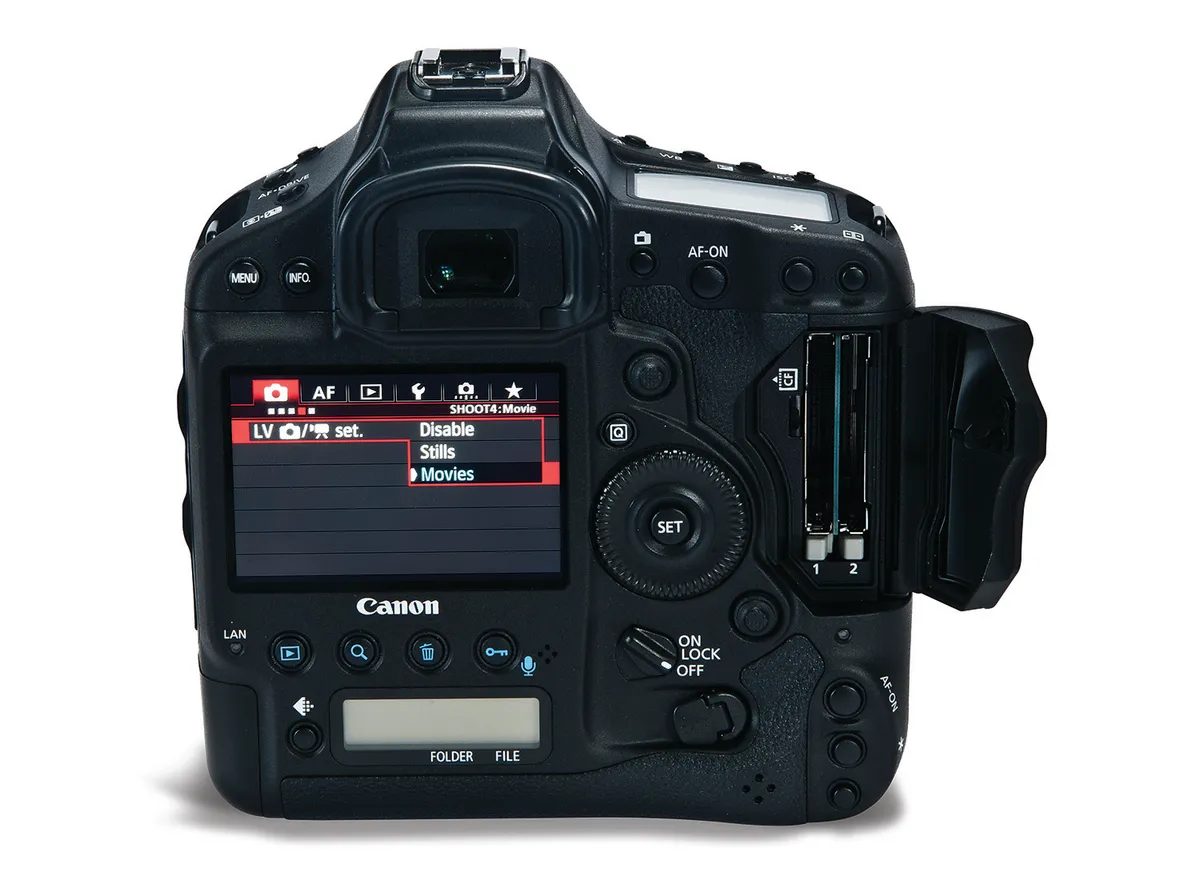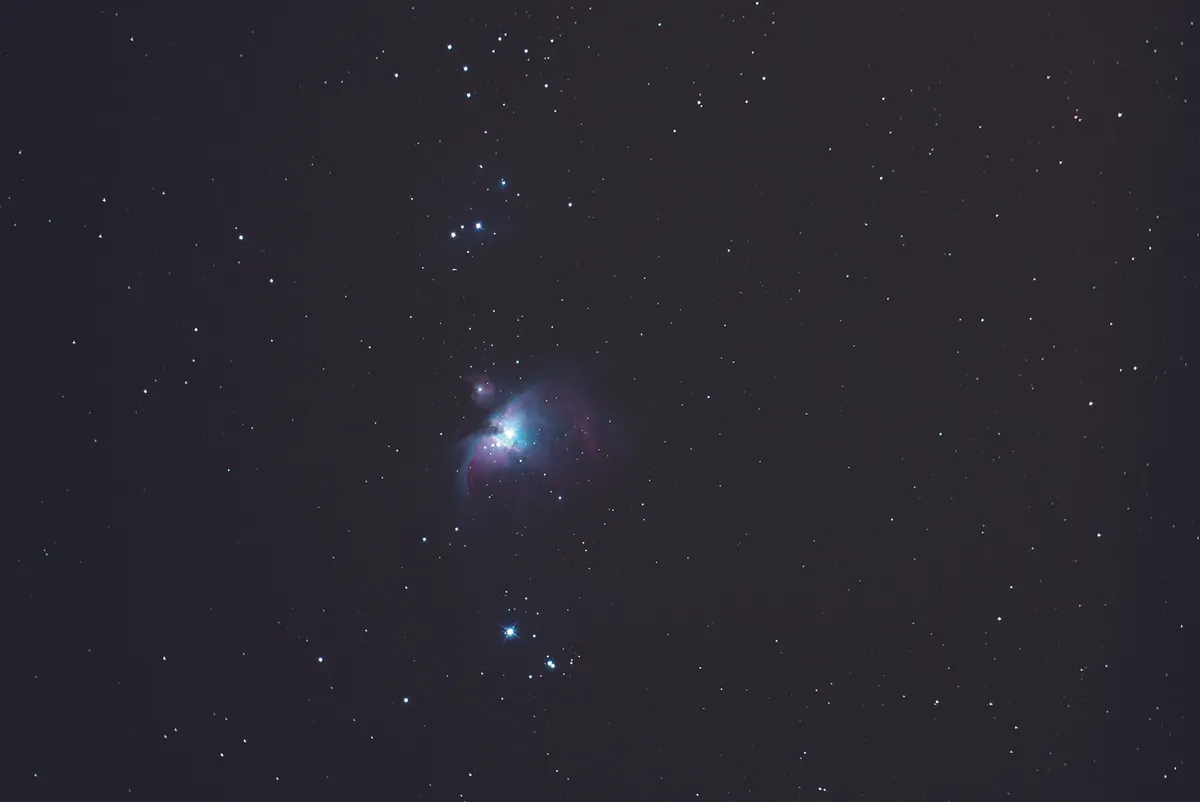The Canon EOS-1D X is aimed squarely at professional photographers. It is a superb tool with an array of well implemented and advanced functions. As well as offering a full-frame sensor, it shoots full-resolution JPEG images up to 14 frames per second (fps), or 12fps if you prefer using the RAW file format.
It uses a 61-point auto-focus system, has 100,000-pixel RGB auto-exposure metering and can record movies at HD (1080p) resolution.
Many of these functions are not of direct interest for astrophotography, although there are times that they may come in useful.
The high shooting rate would be invaluable, for example, during a total eclipse of the Sun. What caught our attention was the camera’s enormous ISO range, which extends up to 204800.
ISO is used to indicate the sensitivity of a camera. In the days of film, ISO related to how long it would take a photographic emulsion to produce an image of a specific density when exposed to light.
Low ISO (slow) film required a longer exposure than high ISO (fast) film to reach the same image density. Fast film suffered from a coarser image grain, which gave results that didn’t look as clean and smooth as that produced by slower film.
Keep your DSLR images pristine with our guide on how to clean a DSLR camera.
Get the most out of your camera with our DSLR guide.
This camera is on our list of the best cameras for astrophotography.

The ISO setting on a digital camera, on the other hand, indicates the amount of internal amplification (gain) that will be applied to an image before it is released and is set so it closely relates to film ISO speeds.
Unfortunately, high digital ISO also produces issues in terms of increased noise and loss of dynamic range or tone.
In this review we’re examining how the camera performs for astrophotography. In particular, we’re looking at its extended ISO range and how it deals with the above issues. Our final scores reflect our assessment in terms of astrophotography.
It’s probably fair to say that our expectations for the top ISO settings weren’t great. If you push any camera to its highest ISO, you will get the worst results it can produce. The big question is how far up the ISO scale you can go before the quality becomes too poor to use.
Again, this is subjective, but from our tests we’d say that anything up to ISO 12800 is acceptable for use. Beyond this threshold, noise becomes more of a problem. Images taken at ISO 100-400 were very clean indeed.
After fitting the camera to a 130mm, f/3.3 astrograph we aimed it at the Sword of Orion.
A 20-second exposure showed little background noise at ISO 3200 and revealed a lot of the faint looping nebulosity that exists around the Orion Nebula, M42.

Unfortunately, being a general purpose photographic camera, this model is fitted with an infrared filter that also blocks some of the important hydrogen-alpha light released by emission nebulae such as this one.
The filter tends to reduce the true pinkish-red colours that should be present and create an image that is much too blue.
The same region imaged at ISO 6400 also produced a perfectly acceptable result after just 10 seconds. This is great news if you want to attach the camera to a telescope and your driven mount isn’t too accurate.
The dynamic range at mid-to-high ISO settings (up to 12800) also seems very acceptable and the images we obtained had a rich tonal range.
Our wide-field shots, obtained using a standard 24mm lens, were similarly impressive, getting down to very faint levels in just a few seconds.
This camera would be fantastic for Milky Way shots taken from a static tripod, the short exposures allowing you to avoid visible trailing. Similarly, with the ISO set to mid-to-high, it would make a fantastic meteor camera.
The biting question is whether this camera is worth its hefty price tag just for astrophotography. In this respect, we’d probably have to say that the benefit over earlier models isn’t enough of a justification.
However, if you’re looking to upgrade your camera for general use and have an interest in astrophotography, this changes the goalposts and the brilliant EOS-1D X is then certainly worth serious consideration.
It is best suited to beginner and intermediate imagers, as high-end astrophotography remains the realm of the cooled astronomical CCD camera.

Staggering ISO range
As far as astrophotography goes, the headline feature of the Canon EOS-1D X is its extended ISO range. The camera can be set to ISO 100-51200 in one-third or whole- stop increments. An additional boost facility adds ISO 50 (L), 102400 (H1) and 204800 (H2).
With higher ISO settings comes greater image noise and loss of dynamic range, but the camera does a decent job of keeping these issues under control for the middle settings.
Dynamic range determines the tonal quality of the image and is amazingly good with this camera at mid-ISO values.Our images were very acceptable at ISOs below 12800. Noticeable background noise starts to appear at higher ISOs.
The question of image acceptability is subjective, and depends on what you’re trying to do and your level of experience.
For a beginner or intermediate imager, this is undoubtedly an impressive tool. The mid-to-high ISO settings are ideal for meteor photography where high sensitivity over short exposures is ideal.
Storage and communication
There are two CF type I/II card slots so you need never run out of memory again. In addition, the camera is compatible with optional WFT-E6 and WFT-E7 wireless transmitters, and offers network connectivity through an RJ-45 ethernet port. Both methods can be used for high-speed image transfer.
Movie mode
The camera can record full HD (1080p) movies. For lunar and planetary imagers, this opens up the possibility of high frame rate captures, but as video compression is used don’t expect results to rival the current crop of dedicated planetary cameras. Capture rates are up to 24fps at 1920x1080 resolution, and 60fps at 1280x720 and 640x480 resolution.
Preview screen
Images are reviewed on this 1,040,000 pixel, Clear View II TFT LCD screen. There’s also an interface to set options as well as the focus assist live view display. The screen does not pivot out for easy viewing at tricky angles, something that would be useful for astrophotographers.
18 megapixel sensor
The camera incorporates a full frame (36mm x 24mm) 18 megapixel CMOS sensor. Full frame means no crop factor; each lens you use delivers images to its intended scale. The sensor uses gapless microlenses to direct as much light onto each pixel detector as possible. Combined with a redesign of the detectors, this gives the sensor its extended ISO capabilities.
DSLR body
At 1.34kg, the camera’s body is noticeably heavy to hold. It is made from magnesium alloy and is environmentally sealed, which is great news if – as can be the case with astrophotography – you need to leave your camera outside in damp conditions. If you’re into creative astrophotography, it’s worth noting that there is no in-built flash.
Vital stats
- Price £5,299
- Sensor 36mm x 24mm CMOS, 5184 x 3456 pixels
- Lens compatibility Canon EF, no crop factor
- Size 158mm x 164mm x 83mm
- Weight 1.34 kg
- Supplier Canon UK
- www.canon.co.uk
This review originally appeared in the March 2013 issue of BBC Sky at Night Magazine.
